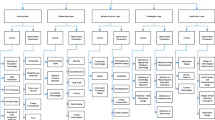Abstract
To apply the internet of things (IoT) to the medical operation system of the new era under the e-commerce online to offline (O2O) mode to realize the intelligent management of medical operation, first, the theoretical basis of the medical e-commerce O2O mode is put forward. First, the theoretical basis of O2O mode of medical e-commerce is proposed, and the reactive algorithm in a cloud computing environment is proposed. Based on the reactive algorithm, the medical IoT operation information platform is designed, including technical framework, development platform and operating framework; then, the database is designed, including user information management database, online registration database, parallel diagnosis service database, and electronic medical record database; the local area network (LAN) is used to realize the basic medical services under the management of the IoT by means of online registration simulation; the performance of the platform is tested, and the test index is the concurrent connection number. The proposed platform is applied to three different hospitals (H, R and K). June 2019 and August 2019 are taken as two-time nodes before and after the use of the proposed platform in three hospitals, and the relevant income of each hospital is counted. The results show that under the premise that the amount of resource increase is 60, and the concurrent connection number is 60, it is necessary to wait for 8 s before the system starts to increase the number of connections (resources), indicating that the threshold exerts a great effect on the algorithm. Meanwhile, the reactive algorithm cannot maintain the same rate. It will cause a slight stagnation according to the load state of the system. The total income of H and K hospitals decreases after using the proposed medical IoT operation information platform. However, the medical income and drug income increase, the ratio of drug income to total income increases significantly, and the proportion of K hospital increases about 0.3. The conclusion is that under the medical e-commerce O2O mode, the reactive algorithm proposed can be applied to the design of the medical IoT operation information platform, and the actual performance of the platform meets the expected results.





Similar content being viewed by others
References
Abdulghaffar AA, Mostafa SM, Alsaleh A et al (2020) IOT based multiple disease monitoring and health improvement system. J Ambient Intell Humaniz Comput 11(3):1021–1029
Al-Fuqaha A, Guizani M, Mohammadi M et al (2015) IOT: a survey on enabling technologies, protocols, and applications. IEEE Commun Surv Tutor 17(4):2347–2376
Cristina U, Francisco A, González-Parada E et al (2016) Rule-based vs. behavior-based self-deployment for mobile wireless sensor networks. Sensors 16(7):1047
Ferrández PF, García CJ, Mario NH et al (2016) Developing ubiquitous sensor network platform using IOT: application in precision agriculture. Sensors 16(8):1141
Hadidi N (2016) Appointment scheme as compared to random service and arrival times from specific distributions. Adv Appl Probab 8(2):250–252
Kaur P, Mahajan M (2015) Integration of heterogeneous cloud storages through an intermediate WCF service. Int J Inf Eng Electron Bus 7(3):45–51
Keikha L, Farajollah SSS, Safdari R et al (2018) Developments of key data element of thalassemia information management systems for Iran. Iran J Public Health 47(11):1775–1776
Liang C, Gu D, Tao F et al (2017) Influence of mechanism of patient-accessible hospital information system implementation on doctor–patient relationships: a service fairness perspective. Inf Manag 54(1):57–72
Liu C, Nitschke P, Williams S et al (2020) Data quality and the internet of things. Computing 102(2):573–599
Long Y, Shi P (2017) Pricing strategies of tour operator and online travel agency based on cooperation to achieve O2O mode. Tour Manag 62:302–311
Lu Y, Cheung YM, Tang YY (2020) Bayes imbalance impact index: a measure of class imbalanced data set for classification problem. IEEE Trans Neural Netw Learn Syst 31(9):3525–3539
Mao AY, Song YY, Yu JX (2015) The realization of the O2O mode in mobile e-commerce based on the technology of the Wechat platform. Appl Mech Mater 743:641–645
Mavrinac M, Brumini G, Petroveki M (2016) Midwifery education introduce the IOT. Stud Health Technol Inform 221:124
Medhi S, Bora A, Bezboruah T (2017) Investigations on some aspects of reliability of content based routing SOAP based windows communication foundation services. Int J Inf Retr Res 7(1):17–31
Miles S (2015) Stakeholder theory classification: a theoretical and empirical evaluation of definitions. J Bus Ethics 142(3):1–23
Mishra P, Lewis J, Patankar A et al (2015) TU-CD-304-11: veritas 2.0: a cloud-based tool to facilitate research and innovation. Med Phys 42(6):3601
Sheth A, Jaimini U, Yip HY (2018) How will the IOT enable augmented personalized health? IEEE Intell Syst 33(1):89–97
Thorn JC, Turner E, Hounsome L et al (2016) Validation of the hospital episode statistics outpatient dataset in England. Pharmacoeconomics 34(2):161–168
Wang S, Liu H, Liu K (2015) An improved clustering cooperative spectrum sensing algorithm based on modified double-threshold energy detection and its optimization in cognitive wireless sensor networks. Int J Distrib Sens Netw 2015(3):1–7
Author information
Authors and Affiliations
Corresponding author
Additional information
Publisher's Note
Springer Nature remains neutral with regard to jurisdictional claims in published maps and institutional affiliations.
Rights and permissions
About this article
Cite this article
Shao, X. The design of medical IoT operation information platform using reactive algorithm and e-commerce O2O mode. Netw Model Anal Health Inform Bioinforma 10, 4 (2021). https://doi.org/10.1007/s13721-020-00277-0
Received:
Revised:
Accepted:
Published:
DOI: https://doi.org/10.1007/s13721-020-00277-0




